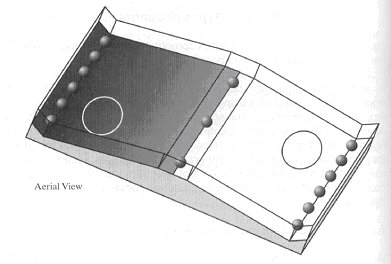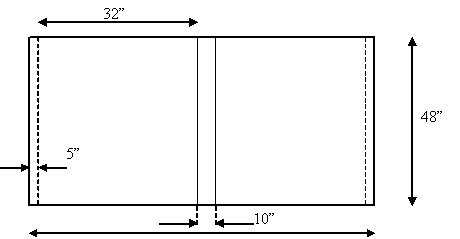

Robo-Pong playing table, which is approximately four by six feet in size is shown in the below diagram. The table consists of two inclined surfaces with a small plateau area (4’ by 10”) in the center. Robots will start the round in diagonally opposite corners of the table (indicated as the large circled starting areas, 1 ft in diameter). Six balls will rest at the base of each ramp (the ball troughs), and three balls will be placed on the plateau. The two sides of the table are painted in solid contrasting colors so that robots could use light sensors to determine which side of the table they are on.
 |
 |
 |
 |
Successful Lego Robo-Pong robots needed to be able to go uphill and downhill, maneuver in the trough area, and coordinate activities of collecting and delivering balls to opponent’s side.
At the end of the 3 minutes of competition time, the referee will terminate the round and count the number of balls on each side. The robot that has the most number of balls on opponent’s side will win the competition.
The Robo-Pong robots are not allowed to interfere intentionally with the operation of their opponents. If there is an unintentional entanglement of the robots that will immobilize one or both of the robots, the referee will stop the clock, place the robots to their starting positions, and restart the clock for the remaining time.
Before the competition, the robots will be measured by placing them into a 1×1×1 ft box. The robots must completely fit the box (nothing should be sticking out) to qualify for the competition.The robots are not allowed to contain Lego parts/sensors/motors other than what is provided in the standard competition kits that will be provided by SIUE.In addition, the Lego pieces can’t be taped, glued, or attached to each other using nonstandard methods.The playing table will be available in late October for teams to test their designs.
The competition will take place in two steps.
Saturday, November 22, 9:00am – 12:00pm, six area high school teams, namely East St. Louis, Edwardsville, Columbia, Highland, Collinsville, and Alton will compete. Each High School is expected to form 4 teams of 3-4 members. We are expecting a total of 24 teams. Each team will be assigned to a group, made out of 4 teams. Each team will have 4 matches in these groups. A win will bring 2 points, a tie will bring 1 point, and a loss will bring zero point. After the round robin competition in each group, top three teams from each group will advance to the next round. The second round will be a loser out tournament between randomly paired 18 teams and there will be 9 matches. In this round, in case of a tie, the teams will rematch in a 1-minute round to break the tie. If tie persists, the 1-minute round will be repeated until a clear winner is determined. At the end of 2nd round, the remaining 9 teams are guaranteed to advance to the next level of competition where they will face the teams from SIUE freshman engineering class. The top 9 teams will continue the competition in groups of 3, once again in a round robin format. The top teams from each group will move to the final round of the competition. Finally, the top 3 teams will match with each other until a clear ranking of 1, 2, and 3 is determined.
The second leg of the competition is scheduled for Tuesday, December 9, 9:00am – 12:00pm. In this phase of the competition, top 9 high school teams will meet with about 20 teams from SIUE Freshman Engineering class. The match format will be similar to the first phase of the competition and each high school team will be assigned to a group with some SIUE teams. Further information about this step of the competition will be provided as the number of teams from SIUE is finalized.
Clarifications: